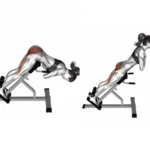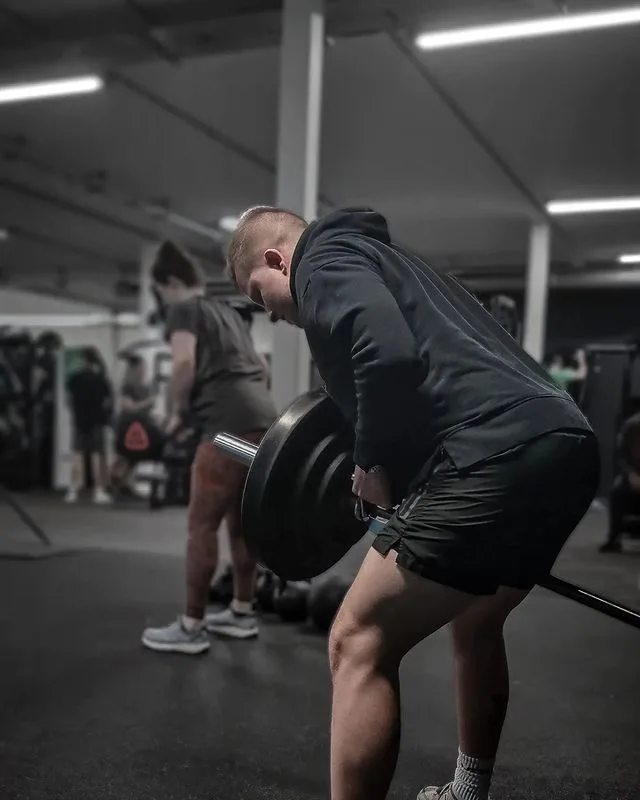The hyper extension exercise is a great way to improve the strength and stability of the lower back, glutes, and hamstrings.
Muscle worked
Muscles targeted by the hyper extension exercise:
- Erector spinae
- Glutes
- Hamstrings
- Core
The primary muscle targeted by the hyper extension exercise is the erector spinae, which is a group of muscles that run along the spine and help to extend the back. Other muscles that are activated to a lesser extent include the glutes, hamstrings, and core muscles.
These muscles work together to extend the back, maintain good posture, and provide stability and support for the spine. By strengthening these muscles, the hyper extension exercise can help to improve posture, prevent back pain, and increase overall back strength.
What is Hyper Extension?

Hyper extension is a strength training exercise that targets the muscles of the lower back, glutes, and hamstrings. It is performed using a special piece of equipment known as a back extension machine or Roman chair. The exercise involves leaning forward and then extending the back to raise the torso back up to the starting position.
The hyper extension exercise is also known by a variety of other names, including:
- Back extension
- Hyperextension
- Roman chair exercise
- Reverse hyperextension
- Glute-ham raise
- 45-degree back extension
Is it compound or isolation exercise
The hyper extension exercise is considered a compound exercise. This means that it works multiple muscle groups simultaneously, rather than isolating a single muscle group.
In the case of the back extension, it works the lower back (erector spinae), glutes, hamstrings, and core muscles, all of which are activated to some extent during the movement.
Compound exercises like the hyperextension are typically considered more effective for building overall strength and fitness, as they engage multiple muscle groups and provide a greater overall training stimulus compared to isolation exercises.
Benefits of Hyper Extensions
The potential benefits of the hyper extension exercise is explained below, which have been scientifically reviewed and supported by several studies, including:
- Improving posture: By strengthening the muscles of the lower back, particularly the erector spinae, the hyper extension can help to improve posture by reducing the risk of lower back pain and reducing the likelihood of spinal misalignment. 1 2
- Preventing lower back pain: By strengthening the lower back, the hyper extension can help to reduce the risk of lower back pain, as well as alleviate existing lower back pain by improving the stability and support of the spine. 1 3
- Increasing core stability: The hyper extension exercise also works the core muscles, which helps to improve overall core stability and balance. 4 5
- Improving athletic performance: By strengthening the lower back and core muscles, the exercise can help to improve athletic performance, particularly in activities that require a strong and stable lower back, such as weightlifting, gymnastics, and some sports. 6 1
How to do Hyper Extension or Back Extension
To get the most out of the back extension exercise, it’s important to use proper form and technique during the exercise to avoid injury. Avoid arching your back excessively, and keep your movements slow and controlled. Gradually increase the weight used over time as your muscles become stronger.
Here are the step-by-step instructions with tips and techniques, common mistakes, which can help to perform the back extension exercise effectively and safely, and maximize the benefits for your lower back and overall fitness.
Setup and movement
- Setup: Begin by positioning yourself on a hyper extension bench with your stomach facing down, and your legs secured under the pads.
- Starting position: Lower your torso until your upper body is parallel to the floor. Keep your hands behind your head or crossed over your chest.
- Movement: Slowly raise your torso upwards until your back is fully extended. Keep your movement controlled and avoid overextending your back.
- Return to starting position: Slowly lower your torso back down to the starting position.
- Repeat: Perform the desired number of repetitions, taking care to maintain proper form throughout the exercise.
Tips
- Maintain proper form: Keep your movements slow and controlled, and avoid overextending your back. Focus on maintaining a neutral spine position throughout the exercise.
- Gradually increase difficulty: Start with a lighter weight and gradually increase the difficulty over time as your muscles become stronger. This will help you to avoid injury and see the best results from your training.
- Engage your core: Make sure to engage your core muscles during the exercise to help maintain stability and support for your lower back.
- Focus on your breathing: Exhale as you raise your torso, and inhale as you lower it. This will help you to maintain proper control and prevent overexertion.
- Warm up first: Before performing the hyper extension exercise, it is important to warm up to help prepare your muscles for the workout. This can include light cardio and some dynamic stretching exercises.
- Avoid overtraining: As with any exercise, it is important to avoid overtraining, particularly if you are just starting out. Start with a moderate number of repetitions and gradually increase over time.
Common mistakes
- Arching the back excessively: This can put excessive stress on the lower back and increase the risk of injury. Focus on maintaining a neutral spine position throughout the exercise.
- Using too much weight: Starting with too much weight can lead to improper form, which can increase the risk of injury. Gradually increase the weight used over time as your muscles become stronger.
- Jerky movements: Avoid making sudden, jerky movements during the exercise. This can disrupt your balance and increase the risk of injury.
- Neglecting the core: Make sure to engage your core muscles during the exercise to help maintain stability and support for your lower back.
- Not warming up: Failing to warm up before performing the hyper extension exercise can increase the risk of injury and make it more difficult to perform the exercise effectively.
- Overtraining: As with any exercise, it is important to avoid overtraining, particularly if you are just starting out. Start with a moderate number of repetitions and gradually increase over time.
When and how to incorporate Hyper Extension
The this exercise can be incorporated into your workout routine in a variety of ways. Here are some tips on when and how to incorporate it:
- As part of a lower back workout: This extension exercise is specifically targeted towards the lower back muscles, so it is best to include it as part of a lower back workout. This can be done 1–2 times per week, depending on your fitness goals and level of experience.
- As part of a full-body workout: The exercise can also be incorporated into a full-body workout, particularly as a complementary exercise for the glutes, hamstrings, and lower back.
- After warming up: It is best to perform this extension exercise after warming up to help prepare your muscles for the workout. This can include light cardio and some dynamic stretching exercises.
- At the end of a workout: The hyper extension exercise can also be performed at the end of a workout as a finisher, to help build and strengthen the muscles of the lower back.
- Incorporate progressive overload: As with any exercise, it is important to gradually increase the weight used over time as your muscles become stronger. This will help you to see the best results from your training.
Repetitions
The number of repetitions you perform for the hyper extension exercise will depend on your fitness goals and level of experience. Here are some general guidelines:
- Beginners: If you are just starting out, aim to perform 2–3 sets of 8–12 repetitions. Start with a lighter weight and gradually increase the difficulty over time as your muscles become stronger.
- Intermediate to Advanced: If you have more experience, you can aim to perform 3–4 sets of 12–15 repetitions. You may also consider using a heavier weight to challenge your muscles further.
- Bodybuilding: If you are training for bodybuilding, you may aim to perform 4–6 sets of 8–12 repetitions with a heavier weight.
Who can do and don’t
The hyper extension exercise can be suitable for people of various fitness levels, but it may not be appropriate for everyone.
Who can do: People who are looking to improve their lower back strength and stability, and those who are training for overall fitness and wellness. It is also suitable for people with a healthy back who have no history of back pain or injury.
Who should avoid: People who have a history of back pain or injury, particularly if they are experiencing discomfort or pain while performing the exercise. Pregnant women and people with osteoporosis or a similar condition may also want to avoid the exercise.
Bottom line
Hyper extensions are exercises performed to strengthen the muscles of the lower back, particularly the erector spinae. They involve using a hyper extension bench to perform the exercise, which involves lying face down and then raising the torso upwards, while keeping the legs stationary.
The purpose of the hyper extension exercise is to improve the strength and stability of the lower back muscles, which can help to reduce the risk of injury and improve posture. Additionally, the exercise can help to strengthen the glutes and hamstrings, which are important muscles for overall fitness and athletic performance.
By incorporating the hyper extension exercise into your workout routine, you can build a stronger, healthier back, and improve your overall fitness and athletic performance. Whether you are just starting out or are an experienced athlete, the hyper extension exercise can be an effective way to meet your fitness goals and improve your overall health and well-being.
- Yaprak Y. “The effects of back extension training on back muscle strength and spinal range of motion in young females.” Biol Sport. 2013 Sep;30(3):201-6. doi: 10.5604/20831862.1047500. Epub 2013 Jul 22. PMID: 24744489; PMCID: PMC3944566.[↩][↩][↩]
- Fukuda A, Tsushima E, Wada K, Ishibashi Y. “Effects of back extensor strengthening exercises on postural alignment, physical function and performance, self-efficacy, and quality of life in Japanese community-dwelling older adults: A controlled clinical trial.” Phys Ther Res. 2020 Aug 5;23(2):132-142. doi: 10.1298/ptr.E10013. PMID: 33489650; PMCID: PMC7814215.[↩]
- Petering RC, Webb C. “Treatment options for low back pain in athletes.” Sports Health. 2011 Nov;3(6):550-5. doi: 10.1177/1941738111416446. PMID: 23016058; PMCID: PMC3445234.[↩]
- Örgün E, Kurt C, Özsu İ. “The effect of static and dynamic core exercises on dynamic balance, spinal stability, and hip mobility in female office workers.” Turk J Phys Med Rehabil. 2019 Dec 25;66(3):271-280. doi: 10.5606/tftrd.2020.4317. PMID: 33089083; PMCID: PMC7557618.[↩]
- Oliva-Lozano JM, Muyor JM. “Core Muscle Activity During Physical Fitness Exercises: A Systematic Review.” Int J Environ Res Public Health. 2020 Jun 16;17(12):4306. doi: 10.3390/ijerph17124306. PMID: 32560185; PMCID: PMC7345922.[↩]
- Gordon R, Bloxham S. “A Systematic Review of the Effects of Exercise and Physical Activity on Non-Specific Chronic Low Back Pain.” Healthcare (Basel). 2016 Apr 25;4(2):22. doi: 10.3390/healthcare4020022. PMID: 27417610; PMCID: PMC4934575.[↩]















